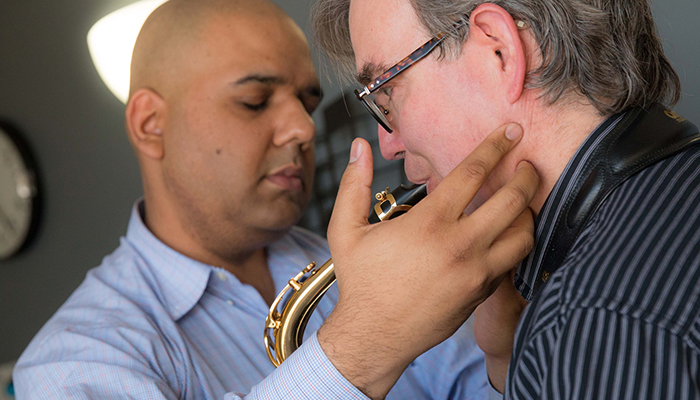Medicine for musicians
By Jan Jarvis
Eric Nestler has played the saxophone on stages all over the world, including Carnegie Hall.
But the accomplished musician and Professor of Music at the University of North Texas feared his career was over when focal dystonia, which caused violent tremors in his face and neck, made it nearly impossible to play his instrument.
Learning to play the flute, however, could help save his career as a saxophonist. By retraining the brain to master a new task, musicians with dystonia are sometimes able to resume playing, said Sajid Surve, DO, Associate Professor of Family Medicine at UNT Health Science Center.
“In Eric’s case, playing the flute uses the same muscles as the saxophone, but in a different way,” said Dr. Surve, who also is Co-Director of the UNT Texas Center for Performing Arts Health. “As he gets better at playing the flute, he will get better at playing the saxophone again.”
A new statewide mandate requires all Texas middle and high school music educators to teach students about health and safety related to their craft. The mandate, which was largely driven by the efforts of the Texas Center for Performing Arts Health, is the first in the nation to address the problem.
Just as athletes often face serious injuries from playing their sports, musicians too can suffer from years of intense practicing. Those risks vary from one instrument to another. Trombone players, for example, are at risk for shoulders injuries. Pianists often suffer hand injuries and harpists frequently get tendonitis from playing the strings.
“Music is an art,” Dr. Surve said. “But playing music should be seen as a task that has risks.”
Such risks include musician’s dystonia, which occurs in about 2 percent of musicians and causes uncontrollable muscle spasms while playing an instrument. In Nestler’s case, focal dystonia caused violent tremors in his neck and face.
“I lost my range and couldn’t play in tune,” he said. “If I played a full-length recital I would be fighting the tremors the entire time.”
Dr. Surve has used a variety of approaches, including osteopathic manipulative treatment, to relax the tense muscles in Nestler’s neck. Nestler has continued teaching, but performing again has been a challenging learning experience.
“Much of my energy is devoted to not letting the tremors occur when I’m playing,” he said. “But now I have range again and able to play in tune, whereas before I couldn’t do that.”







Social media